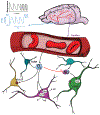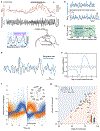Could respiration-driven blood oxygen changes modulate neural activity?
- PMID: 35761104
- PMCID: PMC9794637
- DOI: 10.1007/s00424-022-02721-8
Could respiration-driven blood oxygen changes modulate neural activity?
Abstract
Oxygen is critical for neural metabolism, but under most physiological conditions, oxygen levels in the brain are far more than are required. Oxygen levels can be dynamically increased by increases in respiration rate that are tied to the arousal state of the brain and cognition, and not necessarily linked to exertion by the body. Why these changes in respiration occur when oxygen is already adequate has been a long-standing puzzle. In humans, performance on cognitive tasks can be affected by very high or very low oxygen levels, but whether the physiological changes in blood oxygenation produced by respiration have an appreciable effect is an open question. Oxygen has direct effects on potassium channels, increases the degradation rate of nitric oxide, and is rate limiting for the synthesis of some neuromodulators. We discuss whether oxygenation changes due to respiration contribute to neural dynamics associated with attention and arousal.
Keywords: Cognition; Neural excitability; Nitric oxide; Oxygen; Respiration.
© 2022. The Author(s), under exclusive licence to Springer-Verlag GmbH Germany, part of Springer Nature.
Conflict of interest statement
Competing interests:
The authors have no competing interests to declare that are relevant to the content of this article.
Figures


Similar articles
-
Assessing the physiological concentration and targets of nitric oxide in brain tissue.J Physiol. 2008 Aug 1;586(15):3597-615. doi: 10.1113/jphysiol.2008.154724. Epub 2008 Jun 5. J Physiol. 2008. PMID: 18535091 Free PMC article.
-
Altered respiratory responses to hypoxia in mutant mice deficient in neuronal nitric oxide synthase.J Physiol. 1998 Aug 15;511 ( Pt 1)(Pt 1):273-87. doi: 10.1111/j.1469-7793.1998.273bi.x. J Physiol. 1998. PMID: 9679181 Free PMC article.
-
Synergistic inhibition of respiration in brain mitochondria by nitric oxide and dihydroxyphenylacetic acid (DOPAC). Implications for Parkinson's disease.Neurochem Int. 2005 Aug;47(3):173-82. doi: 10.1016/j.neuint.2005.03.005. Neurochem Int. 2005. PMID: 15893407
-
Nitric oxide and mitochondrial respiration in the heart.Cardiovasc Res. 2007 Jul 15;75(2):283-90. doi: 10.1016/j.cardiores.2007.03.022. Epub 2007 Apr 3. Cardiovasc Res. 2007. PMID: 17466959 Review.
-
Nitric oxide and kidney oxygenation.Curr Opin Nephrol Hypertens. 2009 Jan;18(1):68-73. doi: 10.1097/MNH.0b013e32831c4cdf. Curr Opin Nephrol Hypertens. 2009. PMID: 19077692 Review.
Cited by
-
Behavioral and metabolic effects of escapable electric foot shock stress in male mice.BMC Res Notes. 2025 Mar 25;18(1):127. doi: 10.1186/s13104-025-07189-0. BMC Res Notes. 2025. PMID: 40133962 Free PMC article.
-
Breathing signatures of semantic and phonemic verbal fluency and their impact on test performance in a sample of young Norwegian adults.PLoS One. 2024 Dec 5;19(12):e0314908. doi: 10.1371/journal.pone.0314908. eCollection 2024. PLoS One. 2024. PMID: 39637087 Free PMC article.
-
Reduced removal of waste products from energy metabolism takes center stage in human brain aging.Sci Rep. 2025 Mar 8;15(1):8127. doi: 10.1038/s41598-025-90342-3. Sci Rep. 2025. PMID: 40057554 Free PMC article.
-
Type-I nNOS neurons orchestrate cortical neural activity and vasomotion.bioRxiv [Preprint]. 2025 Feb 11:2025.01.21.634042. doi: 10.1101/2025.01.21.634042. bioRxiv. 2025. PMID: 39896560 Free PMC article. Preprint.
-
Body and mind: how somatic feedback signals shape brain activity and cognition.Pflugers Arch. 2023 Jan;475(1):1-4. doi: 10.1007/s00424-022-02778-5. Pflugers Arch. 2023. PMID: 36503978 Free PMC article. No abstract available.
References
-
- Angelova PR, Kasymov V, Christie I, Sheikhbahaei S, Turovsky E, Marina N, Korsak a, Zwicker J, Teschemacher aG, Ackland GL, Funk GD, Kasparov S, Abramov aY, Gourine aV (2015) Functional Oxygen Sensitivity of Astrocytes. Journal of Neuroscience 35:10460–10473. doi:10.1523/JNEUROSCI.0045-15.2015 - DOI - PMC - PubMed
Publication types
MeSH terms
Substances
Grants and funding
LinkOut - more resources
Full Text Sources

